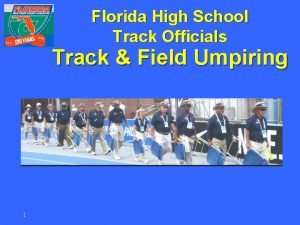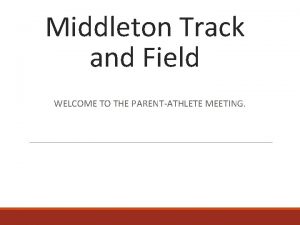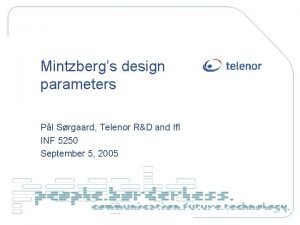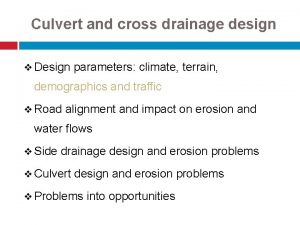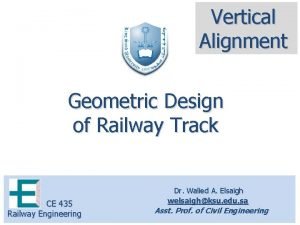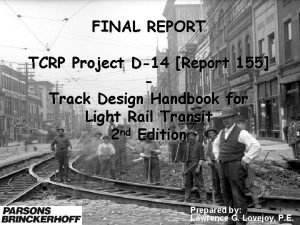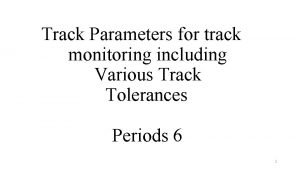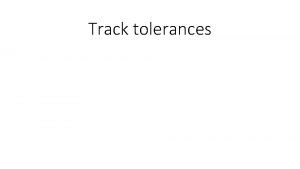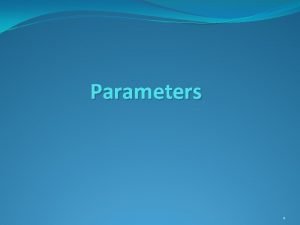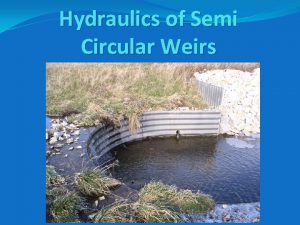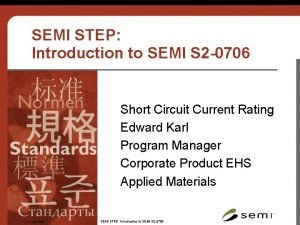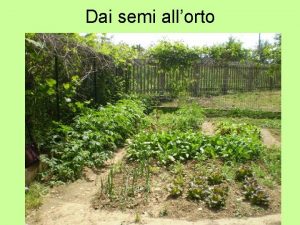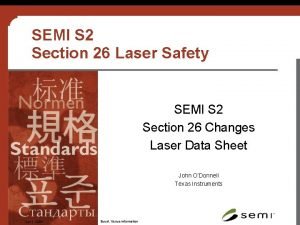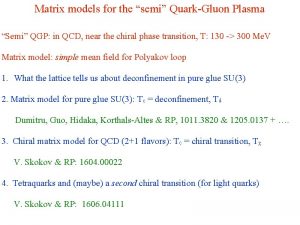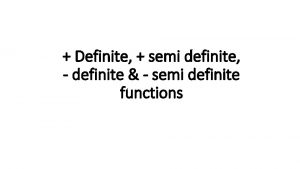Important track design parameters to cater semi high
















- Slides: 16

Important track design parameters to cater semi high speed & heavier axle loads trains Ramesh Pinjani, Senior Professor Bridges IRICEN PUNE

Important track design parameters to cater semi high speed & heavier axle loads trains: Ramesh Pinjani, senior Professor Bridges IRICEN PUNE The paper deals with consideration of important track design parameters mainly i. Static stresses due to vertical bending ii. Dynamic Augment iii. Rail Wheel Contact Stresses iv. Forces due to wheel flat & bad weld v. Target defect wave length measurement & correction vi. Rate of crack propagation due to fatigue flaw in rail /weld vii. Implications of specific locations such as a) curved track b) abrupt change in sub grade stiffness viii. Rate of Track geometry deterioration & factors affecting it ix. Recommendations

Permissible stress: The magnitude of rail stresses considered on various accounts is as under: SN ITEM VALUE IN KG/MM 2 FOR 90 UTS RAIL %AGE OF PERMISSIBLE STRESS 1. Ultimate tensile strength 90. 0 2. Yield strength (52% of average value of observed (UTS) i. e. stress at 2% strain (proof strain) 46. 80 3. Stress for unforeseen reasons such as flexed laying on curve, uneven heating of rail faces etc. @ 10% of yield strength 4. Thermal stresses in LWR 4. 80 10. 2% 10. 75 23% 5. Residual stresses in rails 6. 00 12. 8% 6. Induced stresses due to rolling stock (permissible stresses on yield consideration). 25. 25 54%

Calculation of rail stress due to rolling stock – Theory: beam on elastic foundation The loading considered on Indian Railways for calculation of rail stresses (track stresses) are explained in the figure below: Stresses at centre of foot = stress due to vertical bending Stresses at edge of foot = a + b – c + d

I. Static stresses due to vertical bending Static Stresses in Rail Static Rail seat load for sleeper Vertical stress on ballast bed

Implications: High speed passenger trains 160 kmph 200 kmph No change Heavier axle load freight trains ( increase w. r. t 22. 5 t axle load) 30 t 32. 5 t 33 % increase 44% increase Action proposed-1: The fatigue life of track components mainly Rail, sleeper, Rubber pad, ERC required to be evaluated/ assessed for higher stress cycle. Otherwise under higher stress cycle loading, fatigue failures associated with sudden & abnormal rate of failures of track components may take place, posing serious problems of safety of traffic.

II. Dynamic Augment As per Indian Railway Works practice (RDSO guidelines) the Dynamic Augment is governed by C-100 Report. The dynamic augment reported for various rolling stock at their maximum permitted speed, based on RDSO trials in June-2005 is as under: ROLLING STOCK SPEED (KMPH) DYNAMIC AUGMENT USING WILD (%AGE) Box N 75 55% approx. Box NHS WDM 2 BCN 75 110 75 50% approx. 95% approx. 50% approx.

Implications The high speed means higher dynamic augment, which will result into higher BM & higher stress in rail, higher rail seat load on sleeper & higher vertical stress on ballast bed & formation High speed passenger trains ( Increase w. r. t 130 kmph) 160 kmph 200 kmph 14% 33% Heavier axle load freight trains 30 t 32. 5 t No change Action proposed-2: The maximum stress for track components mainly Rail, sleeper, Rubber pad, ERC under IR track maintenance conditions required to be evaluated/ assessed for higher stress cycle. The concrete sleeper & rubber pad will require to be redesigned. Rails with better metallurgical properties at par with international practices, along with efficient handling practices needs to be introduced.

III. Rail Wheel Contact Stress Implications High speed passenger trains 200 kmph No change Heavier axle load freight trains ( increase w. r. t 22. 5 t axle load) 30 t 15 % increase 32. 5 t 20% increase Action proposed-3: Rail grinding & efficient rail top profile will help the situation.

IV. Forces due to wheel flat & bad weld Figure: vertical force under passage of wheel flat Figure: P 1 & P 2 forces under passage of wheel flat Figure: Dynamic amplification due to bad weld

Implications: High frequency dynamic loads due to poor welds, corrugation and wheel flats are very detrimental to the track. Concrete sleepers are very susceptible to these loads. The properties of rubber pad carries maximum significance. The limiting depth of wheel flat needs to be specified instead of length of wheel flat. Action proposed-4: The limiting depth of wheel flat needs to be specified instead of length of wheel flat. Quality of AT welding requires continuous monitoring & updating to keep at par with international practices V. Target defect wave length measurement & correction The target wave length defects are those critical defects, which are required to be measured during track recording & subsequently eliminated during track maintenance operation. The wavelength of critical defects depends upon speed of the train and natural frequency of suspension system of the train. The maximum disturbance shall occur when wave length of defect λc is such that at a particular speed of train the forced frequency of oscillation (generated due to defect) matches with natural frequency of suspension system.

Rolling stock Box N Natural frequency Suspension (fn) 3. 5 of Speed V (in kmph) 75 Critical wave (λc)=V/fn 5. 95 m Heavy axle load wagon 3. 0 (assumed) 100 9. 25 m ICF coach 1. 2 130 30 m High speed coach 1. 0 (assumed) 200 55. 5 length Action proposed-5: The track monitoring with defect measurement using appropriate chord length is required, to pick up wider& relevant spectrum of track defects in horizontal & vertical mode. VI. Rate of crack propagation due to fatigue flaw in rail /weld Implications: The rate of crack propagation i. e. fatigue failure will increase under heavy axle load & high speed trains. Action proposed-6: The frequency of USFD testing of Rail & weld will require to be increased, Use of spurt car will help to implement it.

VII. Location specific additional factors : Abrupt change in sub grade stiffness The change in stiffness causes increased dynamic forces, the extent of which is determined by speed, stiffness ratio, damping and the length of transition. The semi high speeds trains will require larger transition track to introduce gradual change in stiffness of subgrade on the approach of girder bridges, level crossing, point and crossing. This will help in controlling rate of track geometry deterioration at locations where there is abrupt change in subgrade stiffness. Action proposed-7: The transition tracks at locations involving abrupt change in subgrade stiffness needs to evolved & introduced immediately in new constructions & in phased manner during complete track renewals on existing tracks. In addition better maintenance practices with semi mechanized/ fully mechanized spot attention for these locations needs to be evolved.

VIII. Rate of track geometry deterioration The Rate of track geometry deterioration is governed by following equation based on ORE study report no: D 141 & D 17 E = K, T α P ß V : Where E = deterioration since renewal or last maintenance operation T -= tonnage, P = axle load (static + dynamic) V = speed, K, α, ß, = constants phenomena α ß Rail fatigue 3 3 Track geometry deterioration 1 3 Implications High speed passenger trains ( Increase w. r. t 130 kmph) 160 kmph 200 kmph 51% 136% Heavier axle load freight trains ( increase w. r. t 22. 5 t axle load) 30 t 32. 5 t 137 % increase 200% increase

Factors affecting track geometry deterioration v The quality of the track on relaying was the most important factor. v In general, a high rate of track deterioration in individual areas of a larger section can be linked to characteristics, which are: Ø Local geometry faults present from the start ( Inherent track shape & track inherent quality) Ø Singular features (rail bridges, level crossings, etc. ) i. e. locations involving abrupt change in the subgrade stiffness Ø Sub-layers of inferior quality formation Ø Welds of inferior quality ( Short wave length defects) Actions proposed-8: The quality of track on relaying is the most important factor to affect the rate of track geometry deteriorations. Track can be constructed such that it has a good inherent quality & The inherent quality of existing track can be improved using Design over lift tamping & High lift design tamping.

IX. Recommendations: 1. The fatigue life of track components is required to be evaluated/ assessed for higher stress cycle, including maximum stress under mixed traffic of semi high speed & heavier axle load conditions, to avoid & settle issues related to sudden fatigue failures of track components. 2. The Experience of foreign railways having similar traffic situations needs to be studied to decide track structure and track maintenance planning in terms of finalisation of track tolerances, frequency of track recording & USFD testing for rails and welds, tolerances for rail manufacturing, design of concrete sleeper, concept of under sleeper pad, thickness of sub-ballast and introduction of bituminous layer below sleeper to cater for heavier axle load & semi high speed routes of Indian Railways. 3. The quality of track on initial laying / relaying is the most important factor to affect the rate of track geometry deterioration, therefore track laying quality is to be given due importance. The concept of Design over lift tamping & high lift design tamping needs to be introduced on I. R Thank you
 Semisolid dosage forms definition
Semisolid dosage forms definition A caterer charges $120 to cater a party
A caterer charges $120 to cater a party Cater learner diversity
Cater learner diversity Cater to universal usability
Cater to universal usability What are the five parameters of asl?
What are the five parameters of asl? Florida high school track and field
Florida high school track and field Middleton track and field
Middleton track and field Mintzbergs 5 ps
Mintzbergs 5 ps Course design in esp
Course design in esp Design parameters
Design parameters Design parameters
Design parameters From most important to least important in writing
From most important to least important in writing From most important to least important in writing
From most important to least important in writing Least important to most important
Least important to most important Railway alignment design and geometry
Railway alignment design and geometry Tcrp report 155
Tcrp report 155 Course in senior high
Course in senior high





